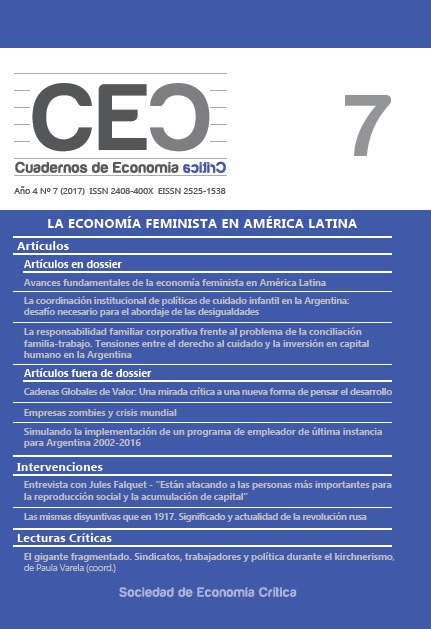Simulating the implementation of an employer of last resort program for Argentina 2002-2016
Keywords:
employer of last resort, unemployment, simulation, fair modelAbstract
The employer of last resort (ELR) proposal provides an alternative to unemployment as the primary means for the stability of the currency's value. Through a "buffer stock" of public workers, it facilitates labor flexibility to and from the private sector. In this way, the ELR acts as an automatic stabilizer, sustaining full employment while promoting price stability. This article simulates an ELR in Argentina using an adaptation of the Fair Model (FM) to examine the effects of the program. Simulated within the historical economic cycle, it is shown that the ELR would allow (permanently) full employment, paying a living minimum wage, without significantly compromising price stability. In addition, full employment would not give rise to an external sector crisis, that is to say, it would not conflict with the "external restraint".
Downloads
References
Fair, R. (2004). Estimating How the Macroeconomy Works, Cambridge, MA: Harvard University Press.
Fair, R. (2013). Macroeconometric Modeling. Recuperado de: http://fairmodel.econ.yale.edu/mmm2/mm.pdf
Fullwiler, S. (2003). “Further Simulations of an Employer of Last Resort Policy”. Center for Full Employment and Price Stability, Working Paper n.° 27, July.
Fullwiler, S. (2005). “Macroeconomic Stabilization Through an Employer of Last Resort”. Center for Full Employment and Price Stability, Working Paper n.° 44, August.
Fullwiler, S. (2012). “The Costs and Benefits of a Job Guarantee: Estimates from a Multi-Country Econometric Model”. En: Murray, M. y Forstater, M. (eds.) The Job Guarantee. Toward True Full Employment. New York: Palgrave Macmillan.
Keynes, J. (1978). “How to Avoid a Slump”. En: Johnson, E. y Moggridge, D. (ed.). The Collected Writings of John Maynard Keynes. Volume 21: Activities 1931-1939. World Crisis and Policies in Britain and America, Royal Economic Society. Trabajo original publicado en 1937.
Lerner, A. (1943). "Functional Finance and the Federal Debt". Social Research, v. 10, pp. 38-51.
Majewski, R. y Nell, E. (2000), “Maintaining Full Employment: Simulating and Employer of Last Resort Program”. Center for Full Employment and Price Stability, Seminar Paper n.° 6, , October.
Mario, A. (2017a). “Sobre la herencia y la pobreza cero: pobreza absoluta por ingresos en Argentina (2003-2016)”. En: García, A. (comp.). Territorio y políticas públicas en el Sur. Buenos Aires: Biblos.
Mario, A. (2017b). “Política social y condicionalidad: ¿puede el Ingreso Ciudadano alcanzar sus objetivos?” [no publicado] Debate Público, Buenos Aires.
Mitchell, B. (1998). “The Buffer Stock Employment Model and the NAIRU: The Path to Full Employment”. Journal of Economic Issues, v. XXXII, n.° 2, junio, pp. 547-555.
Mitchell, B. y Mosler, W. (2001). “Unemployment and fiscal policy”. En: Mitchell, B. y Carlson, E. (eds.) Unemployment: the Tip of the Iceberg, CAER/UNSW Press, Sidney, pp. 219-232.
Mitchell, B. y Wray, R. (2005), “Full Employment through Job Guarantee: a Response to Critics”. CFEPS, Working Paper, n.° 39, January.
Mosler, W. (1997), “Full Employment and Price Stability”. Journal of Post-Keynesian Economics, v. 20, n.° 2, winter, pp. 167-182.
Wray, R. y Tcherneva, P. (2005). “Common Goals-Different Solutions: Can Basic Income and Job Guarantees Deliver Their Own Promises”. Rutgers Journal of Law and Urban Policy, v. 2, n.° 1, pp. 125-163.
Downloads
Published
How to Cite
Issue
Section
License
Copyright (c) 2017 Agustin Mario

This work is licensed under a Creative Commons Attribution-NonCommercial-NoDerivatives 4.0 International License.
Copyright notice
Authors retain copyright and grant the journal the right to be the first publication of the work as licensed under a Creative Commons Attribution License that allows others to share the work with an acknowledgement of authorship of the work and initial publication in this journal.
Authors may separately enter into additional arrangements for non-exclusive distribution of the version of the work published in the journal (e.g., placing it in an institutional repository or publishing it in a book), with an acknowledgement of initial publication in this journal.
Authors are allowed and encouraged to disseminate their work electronically (e.g. in institutional repositories or on their own website) before and during the submission process, as it may lead to productive exchanges, as well as earlier and higher citation of published work (see The Effect of Open Access).























